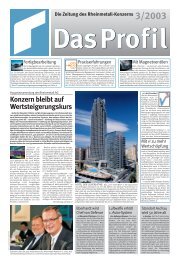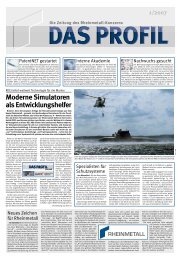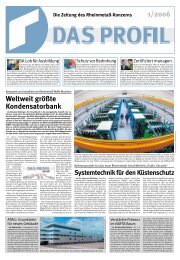PDF [2.5 MB] - Kolbenschmidt Pierburg AG
PDF [2.5 MB] - Kolbenschmidt Pierburg AG
PDF [2.5 MB] - Kolbenschmidt Pierburg AG
You also want an ePaper? Increase the reach of your titles
YUMPU automatically turns print PDFs into web optimized ePapers that Google loves.
Newsline<br />
German biathlon team tests sports rifles in Unterlüß<br />
Sporting order for<br />
environmental experts<br />
Oberhof/Unterlüß. It is minus 22 degrees<br />
Celsius and late September<br />
1999 in Unterlüß. A shot is heard. The<br />
bullet goes straight through the paper<br />
disk, leaving a visible hole. This process<br />
is repeated five times. Having<br />
checked the results, Frank Ullrich, the<br />
coach of the German<br />
men’s biathlon<br />
team is satisfied<br />
since all five<br />
shots hit the same<br />
hole.<br />
September and<br />
freezing temperatures?<br />
Paper disks<br />
and biathlon? How<br />
does this add up?<br />
We are at the tem-<br />
Wolfgang Höfer<br />
perature test facility (TVA) of Rheinmetall<br />
W & M GmbH. The TVA is used to<br />
test products in two test chambers at<br />
temperatures between minus 46 degrees<br />
Celsius and plus 85 degrees Celsius<br />
at a humidity of between 10 and<br />
95 percent. The team headed by TVA<br />
manager Gerhard<br />
Klocke, his deputy<br />
Adrian Müller and<br />
switching controller<br />
Harald<br />
Lembrecht has been<br />
given a sporting<br />
order on a cold winters<br />
day. The coach<br />
of the German biathletesistesting<br />
rifles to be used in<br />
competitions.<br />
Frank Ullrich, the<br />
German men’s<br />
coach and Gerhard<br />
Müssiggang, the<br />
coach of the women’s<br />
team, have<br />
brought some<br />
twenty different rifles<br />
with them. With<br />
Stephan Hoss and<br />
Sandro Brisling, responsible for skiing<br />
and marksmanship, they are testing<br />
their sports rifles at temperatures between<br />
minus 22 and 20 degrees Celsius<br />
before the winter sports season<br />
starts. Each rifle fires five shots at the<br />
target from a distance of 50 meters.<br />
The results are registered and recorded<br />
on video. Wolfgang Höfer, team<br />
leader and responsible for planning<br />
and coordination of the environmental<br />
testing facilities at W & M explains the<br />
background: “The biathletes carried<br />
out these tests to find the best possible<br />
rifle in combination with the most<br />
suitable ammunition at extremely cold<br />
temperatures”:<br />
Low temperatures change the properties<br />
of a rifle. Loads occurring in the<br />
rifle can deform the barrel of the weapon.<br />
In addition, sub-zero temperatures<br />
can have an effect on the ammunition<br />
and on the way in which this is loaded<br />
into the barrel. Ullrich explains:<br />
“To achieve ideal results in a competition,<br />
the rifles must be tailored to low<br />
temperatures. And then there are different<br />
types of ammunition, each of<br />
which has different properties affecting<br />
the accuracy of firing. The best<br />
possible result is obtained if five shots<br />
in succession hit the same hole.<br />
Sandro Brislinger (l), expert marksman, and Marian Riedel, skiing specialist, testing the<br />
rifles of the German men’s biathlon team at minus 22 degrees Celsius in a climatic test<br />
chamber at Unterlüß. The ammunition is also tested under these sub-zero conditions.<br />
The road towards success has not<br />
been easy. Before the coaches started<br />
testing their rifles at Rheinmetall W &<br />
M in Unterlüß, the weapons were tested<br />
in refrigeration chambers in Suhl.<br />
When this system was closed down,<br />
21<br />
Temperature check: Adrian Müller (l),<br />
deputy manager of the temperature test<br />
system, and switching controller Harald<br />
Lembrecht at the electronic control system<br />
for the two climatic test chambers.<br />
they had to find an alternative quickly<br />
as the world championship was not far<br />
away. Ullrich who works with the<br />
sports team of the German Army in<br />
Oberhof heard of Rheinmetall’s temperature<br />
testing facility. “We were incredibly<br />
lucky to have been given this<br />
opportunity since these low-temperature<br />
tests are extremely important to<br />
us. Besides, we were relieved that the<br />
experts in Unterlüß were willing to<br />
help us so quickly.”<br />
The team found ideal rooms and test<br />
conditions in Unterlüß. The sportsmen<br />
paid three two-day visits to the Rheinmetall<br />
site in Lower Saxony during the<br />
last three months<br />
to conduct a series<br />
of tests. Ullrich notes<br />
that “these<br />
tests were very useful<br />
and helped to<br />
improve the hit accuracyconsiderably.<br />
During the last<br />
biathlon world<br />
championship held<br />
in Kontiolathi (Finland)<br />
in 1998, Frank<br />
Luck won a gold<br />
medal for the sprint<br />
and Ricco Groß was<br />
equally successful.<br />
The low-temperature<br />
tests conducted<br />
at the TVA contributed<br />
towards this<br />
success.”<br />
Looking ahead,<br />
Ullrich points out that the next world<br />
championship in Oslo will take place<br />
in February 2000. Who knows,<br />
perhaps the low-temperature tests<br />
performed in Unterlüß will tip the scales<br />
in favor of the biathletes.


![PDF [2.5 MB] - Kolbenschmidt Pierburg AG](https://img.yumpu.com/8112793/20/500x640/pdf-25-mb-kolbenschmidt-pierburg-ag.jpg)
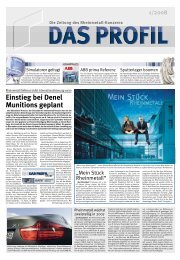



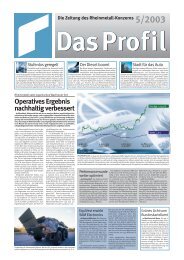
![PDF [1.6 MB] - Kolbenschmidt Pierburg AG](https://img.yumpu.com/8657804/1/171x260/pdf-16-mb-kolbenschmidt-pierburg-ag.jpg?quality=85)
![PDF [2.4 MB] - Kolbenschmidt Pierburg AG](https://img.yumpu.com/8295864/1/184x260/pdf-24-mb-kolbenschmidt-pierburg-ag.jpg?quality=85)




